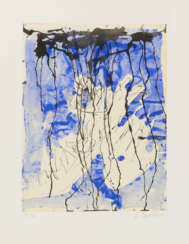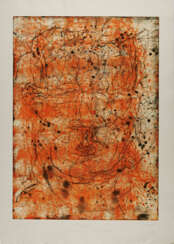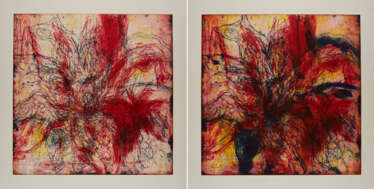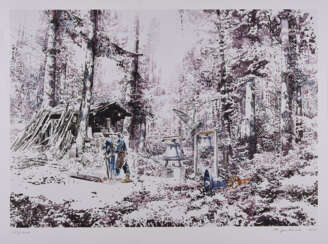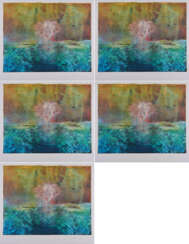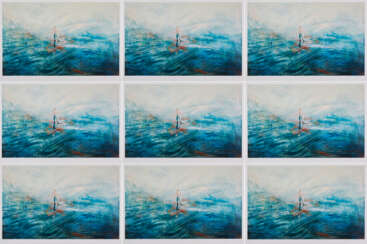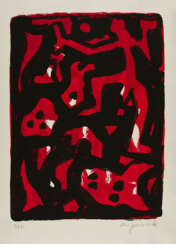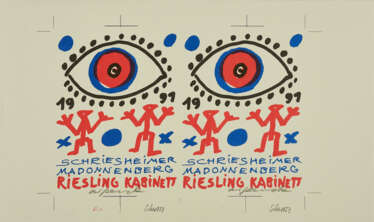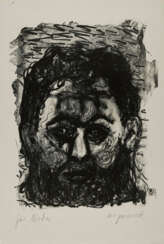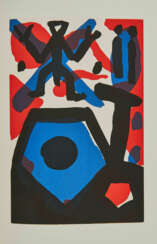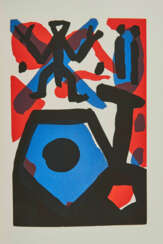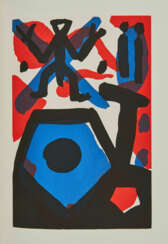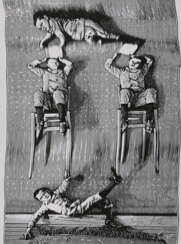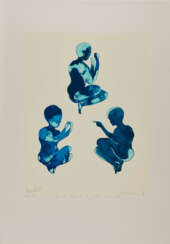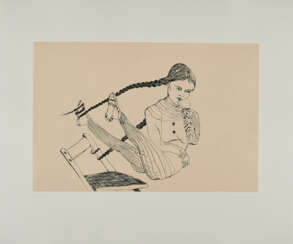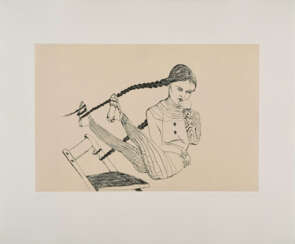
Post War Prints — Galerie Michael Schultz - Part III

Georg Baselitz is a German painter, sculptor and graphic artist. In the 1960s he became well known for his figurative, expressive paintings. In 1969 he began painting his subjects upside down in an effort to overcome the representational, content-driven character of his earlier work and stress the artifice of painting. Drawing from myriad influences, including art of Soviet era illustration art, the Mannerist period and African sculptures, he developed his own, distinct artistic language.
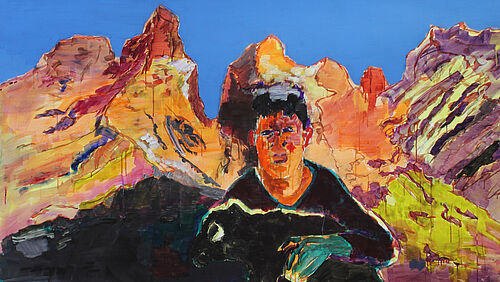
Burkhard Held is German painter living and working in Berlin, Germany. His art is based on figuration dissolving into abstraction. In 1993 he became professor at the Berlin University of the Arts and later served as a professor at the China Academy of Art in Hangzhou, PRC. Burkhard Held is a figurative painter, who dissolves his motifs – landscapes, portraits, flowers – into color fields with a strong tendency towards autonomy. His strongly colored all-over images reinterpret things as abstract and then lead the back into figuration. In 2009 Held started to dedicate himself to the subject of flowers: blossoms become compositions with a landscape character, and are distributed in equally strong colors across the canvas.

Burkhard Held is German painter living and working in Berlin, Germany. His art is based on figuration dissolving into abstraction. In 1993 he became professor at the Berlin University of the Arts and later served as a professor at the China Academy of Art in Hangzhou, PRC. Burkhard Held is a figurative painter, who dissolves his motifs – landscapes, portraits, flowers – into color fields with a strong tendency towards autonomy. His strongly colored all-over images reinterpret things as abstract and then lead the back into figuration. In 2009 Held started to dedicate himself to the subject of flowers: blossoms become compositions with a landscape character, and are distributed in equally strong colors across the canvas.

Malgosia Jankowska is a contemporary Polish and German artist. She studied painting in Berlin and Warsaw. Her works are distinguished by fine strokes, great depth and a high level of detail. Her classical compositions are effective and expressive. Malgosha has been living and working in Berlin since 2001. Since 2006, he has regularly exhibited his work, mainly in Germany.
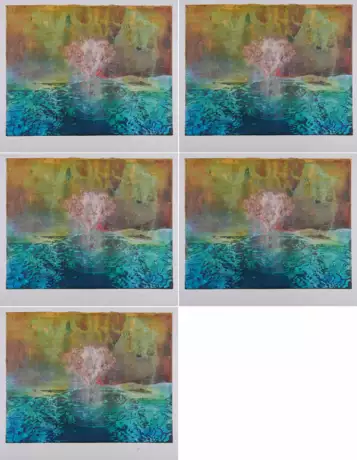
Bernd Kirschner is acontemporary german artist. He studied painting at the Staatliche Akademie der Bildenden Künste in Stuttgart. He lives and works in Berlin and Konstanz. Bernd Kirschner deals in his paintings, which play with figurative and abstract elements, with collective memories and experiences, dreams and subjective perception. His imaginative landscapes invite the viewer to immerse himself mentally in order to decode the deeper symbolism behind the motifs. The mystery of water often becomes the theme. The surfaces of his canvases reveal transcendent, merging color transitions. Bernd Kirschner expresses in his paintings the irrepressible power of nature, which can have not only a calming, but also a worrying effect on people. Recent solo exhibitions of the artist include "Oracles" at the Bank Austria Kunstforum in Vienna ( 2019 ) and "Morphic Fields" at the Kunsthalle Messmer ( 2017 ) in Riegel.

Bernd Kirschner is acontemporary german artist. He studied painting at the Staatliche Akademie der Bildenden Künste in Stuttgart. He lives and works in Berlin and Konstanz. Bernd Kirschner deals in his paintings, which play with figurative and abstract elements, with collective memories and experiences, dreams and subjective perception. His imaginative landscapes invite the viewer to immerse himself mentally in order to decode the deeper symbolism behind the motifs. The mystery of water often becomes the theme. The surfaces of his canvases reveal transcendent, merging color transitions. Bernd Kirschner expresses in his paintings the irrepressible power of nature, which can have not only a calming, but also a worrying effect on people. Recent solo exhibitions of the artist include "Oracles" at the Bank Austria Kunstforum in Vienna ( 2019 ) and "Morphic Fields" at the Kunsthalle Messmer ( 2017 ) in Riegel.
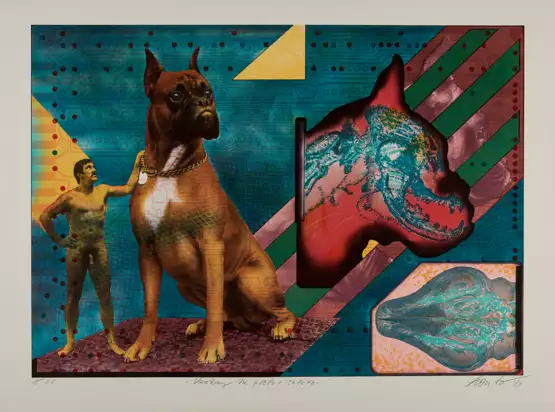
Donatello Losito was an Italian-German painter, graphic artist and object artist. 1955-1958 he trained as a plasterer and restorer. Traveling through France and Italy in 1959/1960, he created his first works in oil and watercolor. Initially he worked as a freelance graphic artist, later he devoted himself entirely to painting. He held solo exhibitions and participated in numerous exhibitions. His main artistic work was created during these years. In 1972, the art critic Helmut Kotschenreuther wrote about the first major solo exhibition: "Losito has an eye sharpened by sensitivity for the grotesque, the comical, the uncanny, the inhumane in our desolate world and at the same time the ability to present the most concise, the "impacting" to find a pictorial formula”.

Donatello Losito was an Italian-German painter, graphic artist and object artist. 1955-1958 he trained as a plasterer and restorer. Traveling through France and Italy in 1959/1960, he created his first works in oil and watercolor. Initially he worked as a freelance graphic artist, later he devoted himself entirely to painting. He held solo exhibitions and participated in numerous exhibitions. His main artistic work was created during these years. In 1972, the art critic Helmut Kotschenreuther wrote about the first major solo exhibition: "Losito has an eye sharpened by sensitivity for the grotesque, the comical, the uncanny, the inhumane in our desolate world and at the same time the ability to present the most concise, the "impacting" to find a pictorial formula”.

Donatello Losito was an Italian-German painter, graphic artist and object artist. 1955-1958 he trained as a plasterer and restorer. Traveling through France and Italy in 1959/1960, he created his first works in oil and watercolor. Initially he worked as a freelance graphic artist, later he devoted himself entirely to painting. He held solo exhibitions and participated in numerous exhibitions. His main artistic work was created during these years. In 1972, the art critic Helmut Kotschenreuther wrote about the first major solo exhibition: "Losito has an eye sharpened by sensitivity for the grotesque, the comical, the uncanny, the inhumane in our desolate world and at the same time the ability to present the most concise, the "impacting" to find a pictorial formula”.

Donatello Losito was an Italian-German painter, graphic artist and object artist. 1955-1958 he trained as a plasterer and restorer. Traveling through France and Italy in 1959/1960, he created his first works in oil and watercolor. Initially he worked as a freelance graphic artist, later he devoted himself entirely to painting. He held solo exhibitions and participated in numerous exhibitions. His main artistic work was created during these years. In 1972, the art critic Helmut Kotschenreuther wrote about the first major solo exhibition: "Losito has an eye sharpened by sensitivity for the grotesque, the comical, the uncanny, the inhumane in our desolate world and at the same time the ability to present the most concise, the "impacting" to find a pictorial formula”.

Donatello Losito was an Italian-German painter, graphic artist and object artist. 1955-1958 he trained as a plasterer and restorer. Traveling through France and Italy in 1959/1960, he created his first works in oil and watercolor. Initially he worked as a freelance graphic artist, later he devoted himself entirely to painting. He held solo exhibitions and participated in numerous exhibitions. His main artistic work was created during these years. In 1972, the art critic Helmut Kotschenreuther wrote about the first major solo exhibition: "Losito has an eye sharpened by sensitivity for the grotesque, the comical, the uncanny, the inhumane in our desolate world and at the same time the ability to present the most concise, the "impacting" to find a pictorial formula”.

Donatello Losito was an Italian-German painter, graphic artist and object artist. 1955-1958 he trained as a plasterer and restorer. Traveling through France and Italy in 1959/1960, he created his first works in oil and watercolor. Initially he worked as a freelance graphic artist, later he devoted himself entirely to painting. He held solo exhibitions and participated in numerous exhibitions. His main artistic work was created during these years. In 1972, the art critic Helmut Kotschenreuther wrote about the first major solo exhibition: "Losito has an eye sharpened by sensitivity for the grotesque, the comical, the uncanny, the inhumane in our desolate world and at the same time the ability to present the most concise, the "impacting" to find a pictorial formula”.

Donatello Losito was an Italian-German painter, graphic artist and object artist. 1955-1958 he trained as a plasterer and restorer. Traveling through France and Italy in 1959/1960, he created his first works in oil and watercolor. Initially he worked as a freelance graphic artist, later he devoted himself entirely to painting. He held solo exhibitions and participated in numerous exhibitions. His main artistic work was created during these years. In 1972, the art critic Helmut Kotschenreuther wrote about the first major solo exhibition: "Losito has an eye sharpened by sensitivity for the grotesque, the comical, the uncanny, the inhumane in our desolate world and at the same time the ability to present the most concise, the "impacting" to find a pictorial formula”.

Ralf Winkler, alias A. R. Penck, was a German painter, printmaker, sculptor, and jazz drummer. A neo-expressionist, he became known for his visual style, reminiscent of the influence of primitive art.

Ralf Winkler, alias A. R. Penck, was a German painter, printmaker, sculptor, and jazz drummer. A neo-expressionist, he became known for his visual style, reminiscent of the influence of primitive art.

Ralf Winkler, alias A. R. Penck, was a German painter, printmaker, sculptor, and jazz drummer. A neo-expressionist, he became known for his visual style, reminiscent of the influence of primitive art.

Ralf Winkler, alias A. R. Penck, was a German painter, printmaker, sculptor, and jazz drummer. A neo-expressionist, he became known for his visual style, reminiscent of the influence of primitive art.

Ralf Winkler, alias A. R. Penck, was a German painter, printmaker, sculptor, and jazz drummer. A neo-expressionist, he became known for his visual style, reminiscent of the influence of primitive art.

Ralf Winkler, alias A. R. Penck, was a German painter, printmaker, sculptor, and jazz drummer. A neo-expressionist, he became known for his visual style, reminiscent of the influence of primitive art.

Ralf Winkler, alias A. R. Penck, was a German painter, printmaker, sculptor, and jazz drummer. A neo-expressionist, he became known for his visual style, reminiscent of the influence of primitive art.

Sigmar Polke was a German painter and photographer.
Polke experimented with a wide range of styles, subject matters and materials. In the 1970s, he concentrated on photography, returning to paint in the 1980s, when he produced abstract works created by chance through chemical reactions between paint and other products. In the last 20 years of his life, he produced paintings focused on historical events and perceptions of them.
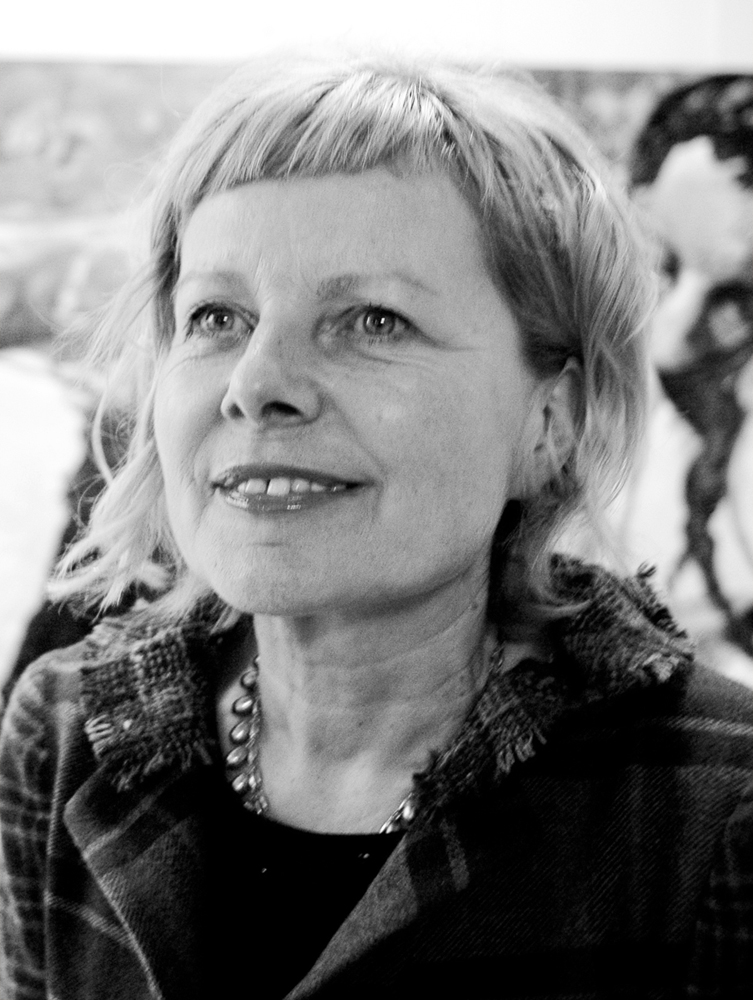
Cornelia Schleime is a German painter, performer, filmmaker and author. She studied painting and graphic arts at the Dresden Academy of Fine Arts before becoming a member of the underground art scene. She was awarded the Hannah Höch Lifetime Achievement Award from the State of Berlin in 2016.
Schleime's painting style is inspired by artists that were a strong influence in her classical studies such as Bacon and Balthus, Monet, Rembrandt, and Van Gogh.
Schleime has focused since the 1990s on figures and large-format portraits. Sources of inspiration are glossy magazines, reproductions of all kinds, but also personal photographs or snapshots found at flea markets. Through the intuitive act of drawing or painting, she turns those she depicts into something creative of her own, projecting them in new roles, symbolically emphasising the poses encountered or highlighting aspects with a touch of fantasy and irony.

Cornelia Schleime is a German painter, performer, filmmaker and author. She studied painting and graphic arts at the Dresden Academy of Fine Arts before becoming a member of the underground art scene. She was awarded the Hannah Höch Lifetime Achievement Award from the State of Berlin in 2016.
Schleime's painting style is inspired by artists that were a strong influence in her classical studies such as Bacon and Balthus, Monet, Rembrandt, and Van Gogh.
Schleime has focused since the 1990s on figures and large-format portraits. Sources of inspiration are glossy magazines, reproductions of all kinds, but also personal photographs or snapshots found at flea markets. Through the intuitive act of drawing or painting, she turns those she depicts into something creative of her own, projecting them in new roles, symbolically emphasising the poses encountered or highlighting aspects with a touch of fantasy and irony.

Cornelia Schleime is a German painter, performer, filmmaker and author. She studied painting and graphic arts at the Dresden Academy of Fine Arts before becoming a member of the underground art scene. She was awarded the Hannah Höch Lifetime Achievement Award from the State of Berlin in 2016.
Schleime's painting style is inspired by artists that were a strong influence in her classical studies such as Bacon and Balthus, Monet, Rembrandt, and Van Gogh.
Schleime has focused since the 1990s on figures and large-format portraits. Sources of inspiration are glossy magazines, reproductions of all kinds, but also personal photographs or snapshots found at flea markets. Through the intuitive act of drawing or painting, she turns those she depicts into something creative of her own, projecting them in new roles, symbolically emphasising the poses encountered or highlighting aspects with a touch of fantasy and irony.
